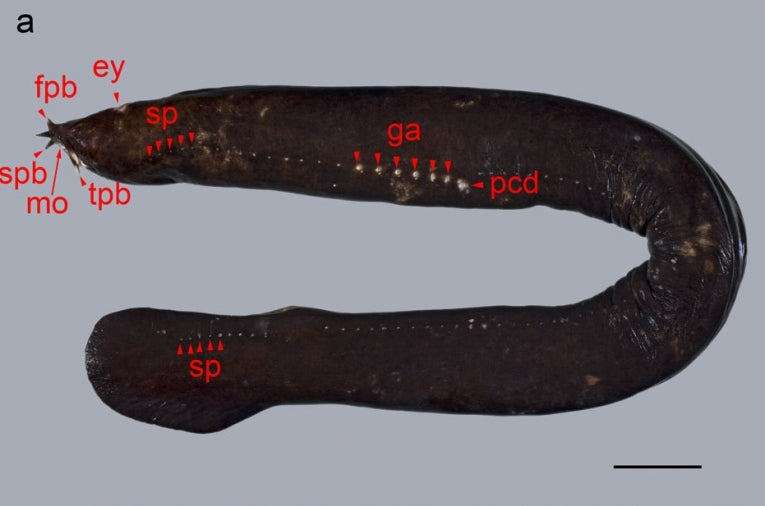That relative of the lamprey, perhaps the ugliest fish in the world, the marine hagfish, has been vastly misunderstood. For years, scientists theorised about how it might absorb nutrients while it was slowly scavenging the ocean floors. Technology has enabled deep sea filming of its real role in its dark niche. Video has now been taken to convict it of the hunting and killing of cute little fish. The evidence is surprising in that this "scavenger" is undoubtedly a hunter and its primitive technique is highly successful for defence too. Sharks and other large predators suffer the same fate as a small prey fish called the red bandfish, Cepola haasti.

The seal shark Dalatias licha (a–c) and the wreckfish Polyprion americanus (d–f) attempt to prey on the hagfishes Eptatretus cirrhatus (a–c) and Eptatretus sp.2 (d–f), respectively. (a),(d), First, the predators approach their potential prey. (b),(e), Predators bite or try to swallow the hagfishes, but hagfishes have already projected jets of slime (arrows) into the predators’ mouth. The slime secretion took less than 0.4 sec. (c),(f), Choking, the predators release the hagfishes and gag in an attempt to remove slime from their mouth and gill chamber. See Supplementary Video S1 for the full sequence of these events in action, along with other examples (Table 1); Credit: © Nature Publishing Group
Hagfishes possess sticky batteries of slime glands and 90 to 200 associated slime pores along the length of their bodies. Using these weapons in a technique unlike that of any other animal, they attempt to coat the vital gills of even large fish to defend themselves. This extracted table shows only the largest fish attempting unsuccessfully to eat a hagfish. The defence forces slime deep into their mouth and gill chamber, causing their withdrawal and often a gagging reaction in less than 0.4 sec. If many hagfish were feeding on bait, as they can be very common, the slime on the bait also prevented other fish from eating.
Small fish suffer a suffocating death when predated because the gills are unable to absorb oxygen into their haemoglobin. As hagfish sit uncomfortably close to our ancestry at the source of Chordate evolution, you may have an ancestor who dribbles slime!
In the video sequence, groups of hagfish rapidly patrolled an area of a Cepola colony. The red band-fish lives in burrows, grouped together. Only one hagfish actually hunted a fish in a burrow, but several entered burrows for a few minutes. By the dead or dying state of the predated fish, slime had been used to incapacitate it. The next stage of investigation of such unique behaviour was to test the slime for toxicity, although analysis has revealed nothing in other tests. We can only assume that the gill-clogging is deadly. Even large predators could be susceptible, as none were followed after they were affected.
Conclusions can only be drawn about the 300 million year history of hagfish. Perhaps their unique nature has protected the 77 extant species. Others may have become extinct simply because they used more conventional niches.










